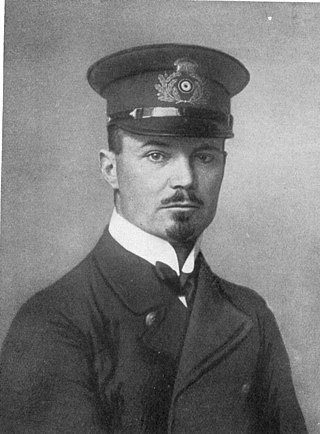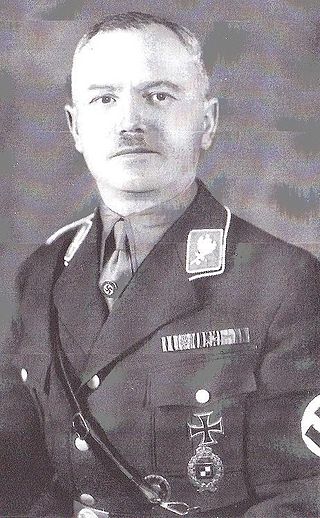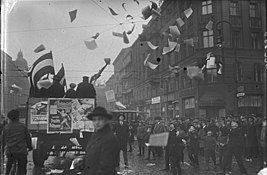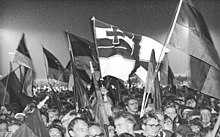
Freikorps were irregular German and other European paramilitary volunteer units that existed from the 18th to the early 20th centuries. They effectively fought as mercenaries or private military companies, regardless of their own nationality. In German-speaking countries, the first so-called Freikorps were formed in the 18th century from native volunteers, enemy renegades, and deserters. These sometimes exotically equipped units served as infantry and cavalry ; sometimes in just company strength and sometimes in formations of up to several thousand strong. There were also various mixed formations or legions. The Prussian von Kleist Freikorps included infantry, jäger, dragoons and hussars. The French Volontaires de Saxe combined uhlans and dragoons.

The Weimar Republic, officially known as the German Reich, was a historical period of Germany from 9 November 1918 to 23 March 1933, during which it was a constitutional federal republic for the first time in history; hence it is also referred to, and unofficially proclaimed itself, as the German Republic. The period's informal name is derived from the city of Weimar, which hosted the constituent assembly that established its government. In English, the republic was usually simply called "Germany", with "Weimar Republic" not commonly used until the 1930s.

The national flag of Germany is a tricolour consisting of three equal horizontal bands displaying the national colours of Germany: black, red, and gold. The flag was first sighted in 1848 in the German Confederation. The flag was also used by the German Empire from 1848 to 1849. It was officially adopted as the national flag of the German Reich from 1919 to 1933, and has been in use since its reintroduction in Federal Republic of Germany in 1949.

The Kapp Putsch, also known as the Kapp–Lüttwitz Putsch, was an attempted coup against the German national government in Berlin on 13 March 1920. Named after its leaders Wolfgang Kapp and Walther von Lüttwitz, its goal was to undo the German Revolution of 1918–1919, overthrow the Weimar Republic, and establish an autocratic government in its place. It was supported by parts of the Reichswehr, as well as nationalist and monarchist factions.

Reichswehr was the official name of the German armed forces during the Weimar Republic and the first years of the Third Reich. After Germany was defeated in World War I, the Imperial German Army was dissolved in order to be reshaped into a peacetime army. From it a provisional Reichswehr was formed in March 1919. Under the terms of the Treaty of Versailles, the rebuilt German Army was subject to severe limitations in size, structure and armament. The official formation of the Reichswehr took place on 1 January 1921 after the limitations had been met. The German armed forces kept the name Reichswehr until Adolf Hitler's 1935 proclamation of the "restoration of military sovereignty", at which point it became part of the new Wehrmacht.

Der Stahlhelm, Bund der Frontsoldaten, commonly known as Der Stahlhelm, was a German First World War veteran's organisation existing from 1918 to 1935. In the late days of the Weimar Republic, it was closely affiliated to the monarchist German National People's Party (DNVP), placed at party gatherings in the position of armed security guards.

The coat of arms of Germany displays a black eagle with a red beak, a red tongue and red feet on a golden field, which is blazoned: Or, an eagle displayed sable beaked langued and membered gules. This is the Bundesadler, formerly known as Reichsadler. It is one of the oldest coats of arms in the world, and today the oldest national symbol used in Europe.
Paramilitary groups were formed throughout the Weimar Republic in the wake of Imperial Germany's defeat in World War I and the ensuing German Revolution. Some were created by political parties to help in recruiting, discipline and in preparation for seizing power. Some were created before World War I. Others were formed by individuals after the war and were called "Freikorps". The party affiliated groups and others were all outside government control, but the Freikorps units were under government control, supply and pay.
These are terms, concepts and ideas that are useful to understanding the political situation in the Weimar Republic. Some are particular to the period and government, while others were just in common usage but have a bearing on the Weimar milieu and political maneuvering.

The flag of Nazi Germany, officially the flag of the German Reich, featured a red background with a black swastika on a white disc. This flag came into use initially as the banner of the Nazi Party (NSDAP) after its foundation. Following the appointment of Adolf Hitler as Chancellor in 1933, this flag was adopted as mandatory for use, while the national one was the black-white-red triband of the German Empire.

The Marinebrigade Ehrhardt, also known as the Ehrhardt Brigade, was a Freikorps unit of the early Weimar Republic. It was formed on 17 February 1919 as the Second Marine Brigade from members of the former Imperial German Navy under the leadership of Hermann Ehrhardt. The brigade was used primarily in the suppression of the Bavarian Soviet Republic and the First Silesian Uprising, both in the first half of 1919. In March 1920, faced with its imminent disbanding by orders of the government in Berlin, the Marine Brigade was one of the main supporters of the Kapp Putsch that tried to overthrow the Weimar Republic. After the putsch failed and the brigade was disbanded in May, many of the former members formed the secret Organisation Consul under Ehrhardt's leadership. Before it was banned in 1922, it carried out numerous assassinations and murders in a continuation of the attempts to overthrow the Republic.

Hermann Ehrhardt was a German naval officer in World War I who became an anti-republican and anti-Semitic German nationalist Freikorps leader during the Weimar Republic. As head of the Marine Brigade Ehrhardt, he was among the best-known Freikorps leaders in the immediate postwar years. The brigade fought against the local soviet republics that arose during the German Revolution of 1918–1919 and later was among the key players in the anti-democratic Kapp Putsch of March 1920. After the brigade's forced disbanding, Ehrhardt used the remnants of his unit to found the Organisation Consul, a secret group that committed numerous politically motivated assassinations. After it was banned in 1922, Ehrhardt formed other less successful groups such as the Bund Viking. Because of his opposition to Adolf Hitler, Ehrhardt was forced to flee Germany in 1934 and lived apolitically in Austria until his death in 1971.

Organisation Consul (O.C.) was an ultra-nationalist and anti-Semitic terrorist organization that operated in the Weimar Republic from 1920 to 1922. It was formed by members of the disbanded Freikorps group Marine Brigade Ehrhardt and was responsible for political assassinations that had the ultimate goal of destroying the Republic and replacing it with a right-wing dictatorship. Its two most prominent victims were the former finance minister Matthias Erzberger and Foreign Minister Walther Rathenau. The group was banned by the German government in 1922.

The term Reichskriegsflagge refers to several war flags and war ensigns used by the German armed forces in history. A total of eight different designs were used in 1848–1849 and between 1867–1871 and 1945.
The Black Reichswehr was the unofficial name for the extra-legal paramilitary formation that was secretly a part of the German military (Reichswehr) during the early years of the Weimar Republic. It was formed in 1921 after the government banned the Freikorps that it had relied on until then to supplement the Reichswehr. General Hans von Seeckt thought that the Reichswehr no longer had enough men available to guard the country's borders, but the army could not be expanded because of the manpower restrictions imposed on it by the Treaty of Versailles. In order to circumvent the limitation, Seeckt created the Black Reichswehr as purportedly civilian "labour battalions" attached to regular Reichswehr units. The Arbeitskommandos received military training, provisioning and orders from the Reichswehr, although ultimately they were never involved in military action. The Black Reichswehr reached a peak membership estimated at 50,000 to 80,000 in 1923 and was dissolved the same year after a group of its members launched the failed Küstrin Putsch. Its existence became widely known in 1925 when its practice of Fememord, the extra-judicial killing of "traitors" among its ranks, was revealed to the public.

The national colours of the Federal Republic of Germany are officially black, red, and gold, defined with the adoption of the West German flag as a tricolour with these colours in 1949. Germany was divided into West Germany and East Germany from 1949 to 1990, and both Germanies retained the black, red, and gold colors on their respective flags. After German reunification in 1990, the united Germany retained the West German flag, thus retaining black, red, and gold as Germany's colors.

The Reichsadler is the heraldic eagle, derived from the Roman eagle standard, used by the Holy Roman Emperors, later by the Emperors of Austria and in modern coat of arms of Austria and Germany.

The Reichsgesetzblatt, was the government gazette of the German Reich from 1871 to 1945, thus covering the German Empire, the Weimar Republic, and Nazi Germany.

Fritz Ritter von Kraußer, born Friedrich Wilhelm Kraußer, was a German military officer who was a highly decorated veteran of the First World War. He later became an SA-Obergruppenführer in the Sturmabteilung (SA), the Nazi Party's paramilitary organization. Kraußer was also a deputy of the Reichstag. He was murdered along with many other SA leaders in the Night of the Long Knives.


































